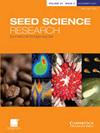水分胁迫下,裂殖穗和裂殖穗碳的再活化提高了锁孔草种子的潜在产量
IF 1.9
3区 生物学
Q2 PLANT SCIENCES
引用次数: 0
摘要
摘要发育信号和环境胁迫调节植物营养器官和生殖器官中的碳分布,并影响种子产量。锁孔草是一种具有潜在生态修复应用价值的旱生草本植物。然而,在水分胁迫下,籽粒灌浆过程中碳水化合物的运输和分布如何影响松果的种子产量尚不清楚。本研究结果表明,在泌乳期,RNA-seq数据显示,在水分胁迫条件下,共有54525个差异表达基因(DEG),但所有对照组之间只有3744个差异表达。加权基因共表达网络分析表明,在水分胁迫条件下,碳水化合物的运输和分布受到ABA响应基因(CsABA8OX1_1、Csabab8OX1_2、Csabab8OX2_1、CsNCED3、CsNCED1_1、Cs NCED1_2和CsNCED4_1)和糖运输和淀粉合成基因(CsSUS1、CsSUS2、CsSSUS3、CsAP1、CsAP4、CsAP5、CsSS1和CsSBE5)的调控。这些基因共同调节来源(茎、叶和鞘)中的碳水化合物再活化,以促进籽粒灌浆和提高种子产量。本研究有助于阐明茎叶等营养器官和CL穗、CH穗等生殖器官在水分胁迫下促进碳水化合物再分配的表型、代谢和转录反应机制,为提高种子产量提供理论指导。本文章由计算机程序翻译,如有差异,请以英文原文为准。
Cleistogamous spike and chasmogamous spike carbon remobilization improve the seed potential yield of Cleistogenes songorica under water stress
Abstract Developmental signals and environmental stresses regulate carbon distribution in the vegetative and reproductive organs of plants and affect seed yield. Cleistogenes songorica is a xerophytic grass with great potential application value in ecological restoration. However, how carbohydrate transport and distribution during grain filling affect the seed yield of C. songorica under water stress is not clear. The present study showed that the soluble sugar and starch contents of cleistogamous (CL) spikes and chasmogamous (CH) spikes were significantly higher at the milk stage, which was attributed to a significantly higher seed number and seed yield per spike under water stress conditions than under well-watered conditions (P < 0.01). RNA-seq data revealed a total of 54,525 differentially expressed genes (DEGs) under water stress conditions, but only 3744 DEGs were shared among all comparison groups. Weighted gene co-expression network analysis showed that the transport and distribution of carbohydrates were regulated by ABA-responsive genes (CsABA8OX1_1, CsABA8OX1_2, CsABA8OX2_1, CsABA8OX2_2, CsNCED3, CsNCED1_1, CsNCED1_2 and CsNCED4_1) and sugar transport and starch synthesis genes (CsSUS1, CsSUS2, CsSUS3, CsAGP1, CsAGP4, CsAGP5, CsSSS1 and CsSBE5) under water stress conditions. These genes jointly regulated carbohydrate remobilization in sources (stems, leaves and sheaths) to promote grain filling and improve seed yield. The present study helped to clarify the phenotypic, metabolic and transcriptional response mechanisms of vegetative organs, such as stems and leaves, and reproductive organs, such as CL spikes and CH spikes, to promote carbohydrate redistribution under water stress, and it provides theoretical guidance for improving seed yields.
求助全文
通过发布文献求助,成功后即可免费获取论文全文。
去求助
来源期刊

Seed Science Research
生物-植物科学
CiteScore
3.60
自引率
4.80%
发文量
23
审稿时长
>12 weeks
期刊介绍:
Seed Science Research, the official journal of the International Society for Seed Science, is a leading international journal featuring high-quality original papers and review articles on the fundamental aspects of seed science, reviewed by internationally distinguished editors. The emphasis is on the physiology, biochemistry, molecular biology and ecology of seeds.
 求助内容:
求助内容: 应助结果提醒方式:
应助结果提醒方式:


